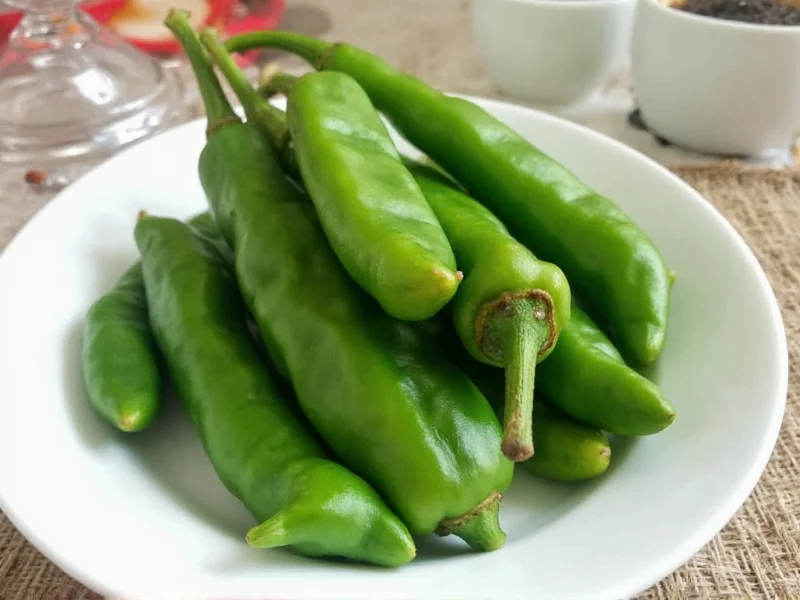Poblano peppers typically range from 1,000 to 2,000 Scoville Heat Units (SHU), classifying them as mild to medium on the heat scale—significantly milder than jalapeños (2,500–8,000 SHU) and exponentially less spicy than habaneros (100,000–350,000 SHU). Their heat level can vary based on growing conditions, ripeness, and seed retention.
Understanding poblano pepper spiciness is essential for home cooks and culinary enthusiasts who want to balance flavor without overwhelming heat. These large, dark green peppers—often roasted and stuffed in dishes like chiles rellenos—offer earthy, rich flavor with just a subtle kick that makes them versatile across cuisines. Unlike their fiery relatives, poblanos deliver complexity rather than intense burn, making them accessible even to those with low spice tolerance.
Decoding the Scoville Scale for Poblano Peppers
The Scoville scale measures capsaicin concentration, the compound responsible for pepper heat. Poblanos sit at the lower end of the spectrum:
| Pepper Variety | Scoville Heat Units (SHU) | Relative Heat Level |
|---|---|---|
| Poblano | 1,000–2,000 | Mild to Medium |
| Jalapeño | 2,500–8,000 | Medium |
| Serrano | 10,000–23,000 | Medium-Hot |
| Habanero | 100,000–350,000 | Very Hot |
This moderate heat profile explains why poblano peppers spicy characteristics make them ideal for dishes requiring nuanced flavor rather than intense heat. When roasted, their natural sweetness emerges, further balancing any subtle spiciness.
Factors That Influence Poblano Pepper Heat Levels
Several variables affect how spicy your poblano might be:
- Ripeness: Green poblanos are milder; as they mature to red (ancho peppers), heat intensifies slightly while sweetness increases
- Growing conditions: Stressors like drought or temperature fluctuations can increase capsaicin production
- Seed and membrane retention: The placenta (white ribs) and seeds contain most capsaicin—removing them reduces heat by up to 80%
- Individual variation: Even within the same plant, heat levels can differ between peppers
Practical Cooking Guidance for Managing Poblano Heat
When working with poblano peppers spicy characteristics in your kitchen:
- For maximum mildness: Select deep green, unblemished peppers and remove all seeds and white membranes before use
- For balanced flavor: Roast poblanos to develop sweetness that counteracts mild heat—this technique works exceptionally well for poblano pepper stuffed recipes
- Heat adjustment: If a dish becomes too spicy, add dairy (sour cream, cheese) or acidic elements (lime juice) to neutralize capsaicin
- Substitution strategy: Bell peppers provide zero heat but lack depth; Anaheim peppers (500–2,500 SHU) offer similar mildness with slightly different flavor
Common Misconceptions About Poblano Heat
Several myths persist about these versatile peppers:
Myth: Poblanos are always mild
Reality: While generally mild, stressed plants can produce peppers approaching 5,000 SHU—still moderate but noticeably hotter than typical poblanos.
Myth: All green peppers are mild
Reality: Color doesn't determine heat—some green peppers like Thai bird chilies (50,000–100,000 SHU) are extremely hot, while poblanos maintain mild characteristics regardless of color stage.
When Poblanos Surpass Expected Heat Levels
Occasionally, you might encounter an unexpectedly spicy poblano. This happens when:
- The pepper experienced drought stress during growth
- It was harvested later in the season when capsaicin concentration peaks
- Genetic variation produced a hotter-than-average specimen
If this occurs, remove additional membrane tissue or balance with dairy-based ingredients. Never assume all poblanos will have identical heat—taste-testing a small piece before full preparation prevents culinary surprises.
Perfect Pairings for Poblano Pepper Dishes
Understanding poblano peppers spicy profile helps create balanced dishes:
- Cheese fillings: Queso fresco or Monterey Jack counteracts mild heat while complementing earthy notes
- Tomato-based sauces: Acidity balances subtle spiciness in dishes like chile verde
- Corn and beans: Traditional pairings that provide textural contrast without competing flavors
- Lime and cilantro: Bright elements that enhance rather than mask the pepper's natural characteristics
FAQs About Poblano Pepper Spiciness
Are poblano peppers hotter than jalapeños?
No, poblanos are significantly milder than jalapeños. Poblanos range from 1,000–2,000 Scoville units while jalapeños range from 2,500–8,000 units. A typical poblano is about half as spicy as the mildest jalapeño.
How can I reduce the heat of poblano peppers?
Remove all seeds and white membrane tissue (placenta), which contain most capsaicin. Soaking sliced peppers in salt water for 30 minutes can further reduce heat. Roasting also diminishes perceived spiciness by developing natural sweetness.
Why are some poblano peppers spicier than others?
Environmental factors like water stress, temperature fluctuations, and soil conditions affect capsaicin production. Even within the same plant, individual peppers can vary in heat due to genetic expression and maturity at harvest.
Are red poblanos spicier than green ones?
Slightly. As poblanos ripen from green to red (becoming anchos), heat increases modestly while sweetness develops. The difference is subtle—typically within the same 1,000–2,000 SHU range—but noticeable when tasted side by side.
Can I use poblano peppers if I don't like spicy food?
Yes, poblano peppers are among the mildest chili varieties. When seeds and membranes are removed, they provide rich flavor with minimal heat—ideal for those with low spice tolerance. Their earthy, slightly sweet profile works well in dishes requiring zero to mild heat.











 浙公网安备
33010002000092号
浙公网安备
33010002000092号 浙B2-20120091-4
浙B2-20120091-4